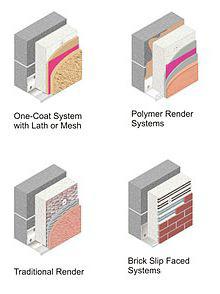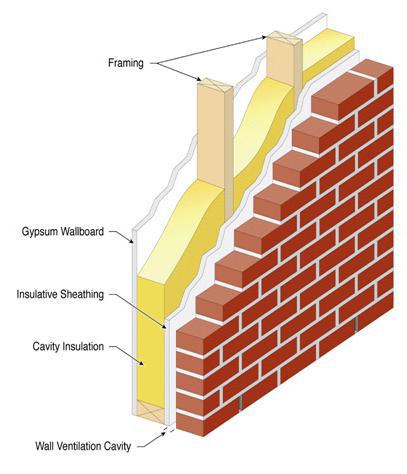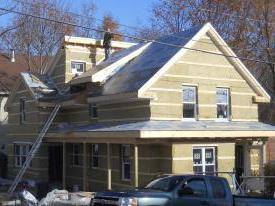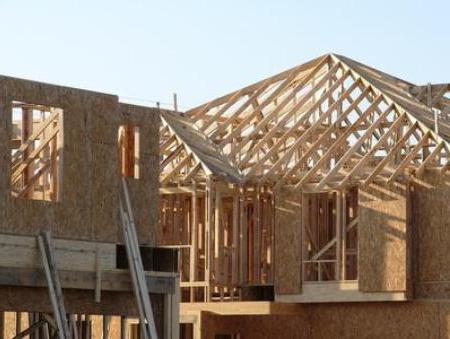Usually very good. In most cases, such buildings do not need insulation. However, cracks and gaps often appear in the walls of old chopped and cobbled structures. It is then that there is a need to isolate the enclosing structures. Of course, this procedure should be carried out strictly adhering to certain technologies. In addition, of course, you need to know what is the best way to insulate wooden houses outside.
What materials will be needed
In order to perform high-quality insulation of wooden walls, you will need to prepare:
- A bar with a section of 50 x 150 mm for the crate. Another option can be used. In this case, it all depends on what thickness the insulation is chosen. Its slabs must be completely recessed into the crate.
- Mineral wool is an excellent answer to the question of how to insulate wooden houses from the outside. The slabs must be sufficiently rigid. This will negate the risk of slipping in the future.
- Vapor barrier and waterproofing films. These materials are necessary to protect the heat insulator from getting wet from the outside and from the inside.
- Bars 40 x 40 cm. They will be used to attach the waterproofing film.
- or lining. These materials are just perfect for upholstering a wooden house.
- Means for treating walls from fungus. It is also advisable to purchase a composition that increases the fire resistance of wood.
What tools will be needed
You will also need to prepare:
- Hammer for hammering in nails.
- Drill for siding installation.
- A knife for cutting a waterproofing film.
Insulation of windows and doors
The question of how to insulate a private house comes down, among other things, to the insulation of openings. Of course, there should be no gaps between window frames and walls. Otherwise, the effect of rather expensive work on the insulation of the building itself will be reduced to zero. If there are gaps, they should first be sealed with concrete mortar. The same goes for the door jamb. The canvas itself will also be nice to insulate. You can buy a ready-made door with a built-in insulator. By the way, the same goes for windows. There are always microcracks in old cracked wooden frames, through which precious heat leaves the house. Therefore, if funds allow, it is worth buying and installing new euro windows. In this case, the profile can be used wooden or cheaper PVC "woodgrain".
Expansion of the foundation
How to insulate the walls of a wooden house, we will consider below. First, let's figure out what needs to be done before that. Of course, the first step is to expand the base of the house. The cake of the walls should rest against something from below. Otherwise, the heat insulator will start to slip. For expansion, reinforcing bars are drilled into the main foundation. Further, formwork is installed along the perimeter of the house. Sand is poured onto the bottom of the resulting "trough". Next, a footing 5 cm thick is poured. Reinforcement is installed on it and connected to the rods drilled into the main foundation. Then the filling is done. After the concrete has hardened, the formwork is removed. From above, the new part of the foundation should be waterproofed with two layers of roofing material.

Insulation of the foundation
In order to make the house as warm as possible, the foundation should be insulated before the walls are insulated. A very good solution would be to use polyurethane foam for this purpose. This material is quite expensive, however, since it retains heat much better than other insulators, it will be needed much less. For a fairly effective insulation, a layer of 3 to 10 cm is needed.
Of course, you can also use expanded polystyrene for this purpose. However, in this case, it is better to purchase products from trusted manufacturers. For example, the foam insulation of the Penoplex brand, the price of which is not too high (100-300 rubles), tolerates the effects of aggressive substances dissolved in the soil very well. In addition, he is absolutely not afraid of moisture. Mineral wool is not recommended for basement insulation. The fact is that this material absorbs water very easily and at the same time loses its insulating properties.
Insulating the walls: preliminary stage
So, let's start to figure out how to insulate a private house, or rather, its facades. First of all, all surfaces must be cleaned of dirt. Further, the timber or log is treated with a means that prevents the appearance of fungus. It is also worth smearing them with compounds that increase fire resistance and destroy insects. Further, all the available slots and grooves are sealed with tow. Caulking should be done in dry weather. Instead of tow, you can use jute or hemp. These materials are pushed into the cracks using a special tool - caulking. After that, you can start actually doing the work on assembling the cake of the walls.

What you need to know about a heat insulator
You already know how to insulate wooden houses outside. Why basalt wool? This material is considered the best choice because foam or expanded polystyrene practically does not allow moisture to pass through. Even if there are ventilation gaps under these materials, a lot of it accumulates. As a result, the cake loses some of its thermal insulation properties, and the log or timber begins to rot.

Even high-quality foam insulation is not suitable for cladding wooden walls. For example, the same Penoplex. The price of mineral wool is lower than that of it. Consequently, the owners of the house do not lose anything in any case. Instead of basalt, you can use glass wool.
Vapor barrier device
The walls are preliminarily covered with a material that prevents moisture from entering the insulation from the inside of the house. As a vapor barrier, you can use plastic wrap or some other more modern analogue. In the event that the walls are thick and assembled from logs, the material can be fixed directly to them. In this case, there will be enough free space between the crowns for effective ventilation. If they are knocked down from boards or made of timber, you will need to arrange an additional gap for ventilation. In this case, the film is stretched onto thin slats pre-fixed to the wall.
Installation of the lathing
So, you now know the answer to the question of what is the best way to insulate a wooden house. Mineral wool slabs are attached to the walls; it is often fixed horizontally. Lining and block house are usually mounted on a vertical frame. The bars are attached to screws or nails. The step between them should be equal to the width of the mineral wool slabs. Sometimes the distance between the battens is made a little smaller. In this case, it will be possible to install the slabs with a frame. The timber must be treated with anti-rot and fire-resistant agents.
Installation of slabs
So, we found out how to insulate wooden houses outside. How to install the plates correctly? The insulation is mounted on top of the vapor barrier film between the beams of the assembled sheathing. Unfortunately, they are often a little uneven. Therefore, gaps may form between the slabs and the battens in some places. It is allowed to seal them with materials such as basalt, jute or flax. To prevent the slabs from falling out and slipping, it is worth additionally securing them with special plastic dowels with wide caps. If the lathing is mounted vertically, sheathe the walls with cotton wool from any corner. If the bars are horizontal, installation is carried out from the bottom up.
Usually insulation is done with a material 5 cm thick. In this case, the installation is carried out in two layers. In this case, the joints of the second are located above the center of the plates of the first. The bottom of the cake will need to be covered with a metal mesh so that mice and insects do not enter it.
Installation of waterproofing film
So, the best insulation for a wooden house is mineral wool. What material should be chosen for a waterproofing device? In this case, it is worth using a special superdiffusion membrane. This material will protect the walls not only from rain, but also from the wind. For wooden houses, it is allowed to use with a vapor permeability of at least 1400 g per m 3.
The film is attached directly to the batten using 40 x 40 mm blocks. This will create a ventilation layer between it and the finish. Lay the film perpendicular to the location of the battens. The overlap between the individual strips should be about 10 cm. Sometimes the joints are additionally glued with construction tape.
Installation of lining
The finishing material is attached to the counter-lattice obtained after installing the waterproofer. There are only two main ways of fixing the lining: nails and special clamps. The first method can be considered the simplest. However, in aesthetics, such a cladding of the one made in two other ways loses a lot. After all, the caps of the carnations will be clearly visible in any case.

Therefore, the lining is often fixed on the crate with clamps. These fasteners are first put on the lamella groove flange, and then on the timber. In this way, a very beautiful coating can be made. In the same way, a block house is attached to the crate.
Insulation of the roof of a wooden house from the outside

In this case, a wire is first attached to the rafters from the back side, and behind it from the inside. Further, insulation plates are installed outside. It is mounted above it. It is attached to the bars. Next, the crate is mounted. The step between its elements depends on the type of roofing material. A continuous crate is arranged under roofing felt and soft tiles. Under the profile, they are mounted sparse with a distance between the elements of 30-50 cm.

Thus, we have figured out how to insulate an old wooden house. As you can see, this procedure is not particularly difficult. The most important thing is to follow the order of work and not violate the technology. In this case, the wooden building will turn out to be warm and cozy, and the ventilated facade and roof themselves will last a long time.



